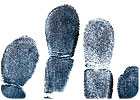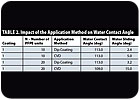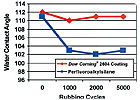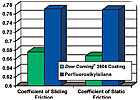Banishing Fingerprints
Advanced perfluoropolyether coatings can provide innovative stay-clean and easy-to-clean surfaces on appliances, electronics, optical lenses, automotive interiors and other products subjected to frequent skin contact.

 Obtaining a surface that is resistant to fouling from fingerprints, skin oil, sweat and cosmetics is a significant hurdle to overcome for consumer products subjected to frequent skin contact, such as appliances, electronics, optical lenses and automotive interiors. Once the surface is contaminated, stains from skin oil, sweat and cosmetics are not easily removed. Surfaces that have an antireflective coating are especially sensitive to surface contamination, which affects aesthetics and also presents safety concerns.
Obtaining a surface that is resistant to fouling from fingerprints, skin oil, sweat and cosmetics is a significant hurdle to overcome for consumer products subjected to frequent skin contact, such as appliances, electronics, optical lenses and automotive interiors. Once the surface is contaminated, stains from skin oil, sweat and cosmetics are not easily removed. Surfaces that have an antireflective coating are especially sensitive to surface contamination, which affects aesthetics and also presents safety concerns.
To solve such problems relating to oil and water repellency, various stain-proofing agents have been proposed. One proposal was a stain-resistant antireflective coating obtained by surface treating a substrate with a perfluoroalkyl-group-containing compound. Another approach was a stain-resistant, low-reflection plastic that had a polyfluoroalkyl group containing mono and disilane compounds and halogen, alkyl, or alkoxysilane compounds as a surface-modification coating. A third option that has been proposed is forming a copolymer of perfluoroalkyl (meth)acrylate and an alkoxy silane group-containing monomer on an optical thin film mainly consisting of silicon dioxide. However, these coatings have insufficient stain-resistance properties, especially on the most important stains such as fingerprints, skin oil, sweat and cosmetics.
Recently, researchers and development partners at Dow Corning Corp. and Daikin Industries, Ltd. determined that obtaining the desired high water and oil contact angles and low sliding angles necessary for high antistaining performance required chemical modification of a linear perfluoropolyether. The resulting technology can be used to create innovative stay-clean and easy-to-clean surface properties on glass and metal, in addition to many common plastics, such as acrylic, poly(methyl methacrylate) (PMMA) and polycarbonate.

The impact of the alkoxysilyl structure on the modified perfluoropolyether was evaluated while keeping the polyether chain length constant (n = 20) using the dip coating application method. The surface properties of the treated glass substrates were compared using the static contact angle and sliding angles of water and oil (n-hexadecane).
As can be seen in Table 1, high water and oil contact angles were observed in all cases. The simpler alkoxysilyl group in Coatings 1 and 3 gave slightly higher static contact angles and slightly lower sliding angles for both water and oil when compared with Coatings 2 and 4. The organic linking group between the silicon and the perfluoropolyether backbone also had a slight impact on the results, with the amide-containing group (Coatings 3 and 4) giving lower water contact angles and higher oil contact angles. The results suggest that a highly stain-resistant surface can be achieved on glass. In all cases, the degree of surface hysteresis (the ability of oil and water to slide over the treated surface) was small, as shown by the low sliding angles.
The effect of perfluoropolyether molecular weight was evaluated by adjusting the degree of polymerization of the polyether backbone in Coating 1. No clear trend was seen for the water and oil contact angles, although the data did suggest that as the perfluoropolyether molecular weight increased, the sliding angle for water also increased. For the oil sliding angle, there was no observable relationship with polymer molecular weight.
 Interestingly, the application method was found to have the most significant impact on the contact angle. While the contact angle data was similar for the two application methods, the CVD application method gave a significantly higher sliding angle for water, regardless of the molecular weight, as shown in Table 2. This behavior suggests that a more uniform coating is formed by using the dip coating application method. The desired performance is achieved with a monolayer coating approximately 2 nm thick. Increased surface roughness results from a nonuniform coating layer, the effect being lower static water contact angles and higher sliding angles.
Interestingly, the application method was found to have the most significant impact on the contact angle. While the contact angle data was similar for the two application methods, the CVD application method gave a significantly higher sliding angle for water, regardless of the molecular weight, as shown in Table 2. This behavior suggests that a more uniform coating is formed by using the dip coating application method. The desired performance is achieved with a monolayer coating approximately 2 nm thick. Increased surface roughness results from a nonuniform coating layer, the effect being lower static water contact angles and higher sliding angles.

 Water and oil contact and sliding angles are important parameters to measure after aging to ensure that the surface is resistant to the elements of a given application and will provide antistain performance over time. Ultraviolet (UV) exposure and rubbing durability of the treated surface are methods commonly used to predict the effective life of the surface modification. The impact of UV exposure on the water contact angle was determined using a sunshine weatherometer, and the results were compared to another commercially known surface treatment (see Figure 1). There was a significant improvement in UV irradiation resistance in the alkoxysilyl perfluoropolyether as measured by the water contact angle over the test period.
Water and oil contact and sliding angles are important parameters to measure after aging to ensure that the surface is resistant to the elements of a given application and will provide antistain performance over time. Ultraviolet (UV) exposure and rubbing durability of the treated surface are methods commonly used to predict the effective life of the surface modification. The impact of UV exposure on the water contact angle was determined using a sunshine weatherometer, and the results were compared to another commercially known surface treatment (see Figure 1). There was a significant improvement in UV irradiation resistance in the alkoxysilyl perfluoropolyether as measured by the water contact angle over the test period.
The effect of rubbing durability is commonly the key parameter when considering the use of the akoxylsilyl perfluoropolyether coating on surfaces that are subjected to physical wear. Applications such as ophthalmic lenses, camera lenses, portable electronic devices and auto interiors require resistance to rubbing to ensure long-term hydrophobic (water-repelling) and oleophobic (oil-repelling) properties. Durability testing typically is carried out using a device that applies a constant pressure on a uniform surface area while cycling from side to side across the surface. The glass test pieces were subjected to a 500-gram force applied by a cotton cloth fixed to an aluminum block. The water-contact angle was measured after various intervals to obtain the relationship with rubbing cycles. A comparative method was used to assess durability, as there are no absolute pass/fail values.
 As can be seen in Figure 2, there was a significant difference in the resistance to rubbing as measured by water-contact angle. After 5,000 cycles, the commercial perfluoroalkylsilane had an 8-degree reduction in water-contact angle, while the alkoxysilyl perfluoropolyether showed only a 1-degree change. The decrease in contact angle of the perfluoroalkylsilane took effect before 1,000 rubbing cycles, and was then constant at 103 degrees for the balance of the test period.
As can be seen in Figure 2, there was a significant difference in the resistance to rubbing as measured by water-contact angle. After 5,000 cycles, the commercial perfluoroalkylsilane had an 8-degree reduction in water-contact angle, while the alkoxysilyl perfluoropolyether showed only a 1-degree change. The decrease in contact angle of the perfluoroalkylsilane took effect before 1,000 rubbing cycles, and was then constant at 103 degrees for the balance of the test period.
 Ease of cleaning also can be improved with the new alkoxysilyl perfluoropolyether technology. A comparison of sliding and static coefficients of friction provided a comparative insight into the easy-to-clean property (Figure 3). The lower sliding and static coefficients of friction indicate that the alkoxysilyl perfluoropolyether has both better stay-clean and easy-to-clean characteristics.
Ease of cleaning also can be improved with the new alkoxysilyl perfluoropolyether technology. A comparison of sliding and static coefficients of friction provided a comparative insight into the easy-to-clean property (Figure 3). The lower sliding and static coefficients of friction indicate that the alkoxysilyl perfluoropolyether has both better stay-clean and easy-to-clean characteristics.
For more information, visit www.dowcorning.com.
Author’s acknowledgement: The following individuals also contributed to this article: Peter Hupfield, senior development specialist, Dow Corning Ltd., United Kingdom; Dr. Yasuo Itami, chief researcher, Daikin Industries Ltd., Japan; Eiji Kitaura, application engineer, Dow Corning Toray Ltd., Japan; Dr. Don Kleyer, associate research scientist, Dow Corning Corp., U.S.; Dr. Tetsuya Masutani, business development manager, Daikin Industries Ltd., Japan; and Dr. Yasuhiro Nakai, research chemist, Daikin Industries Ltd., Japan.
Editor’s note: This article is based on the paper “New Antifingerprint Coatings,” presented at the 11th Annual International Coatings for Plastics Symposium, co-hosted by Paint & Coatings Industry and Finishing Today in April 2008.
1. Clean surface with suitable solvent.
2. Dip glass test piece in a 0.1% solution of the PFPE-silane chemical for 30 seconds.
3. Dry at room temperature and 50% relative humidity for eight hours (alternatively, dry at 122°F [50°C] and 50% relative humidity for one hour).
4. Rinse substrates in a sonication bath.
5. Dry for one hour at room temperature.
Chemical Vapor Deposition (CVD) Method
1. Evaporate diluted PFPE silane on a pourous pellet and place in CVD chamber.
2. Place glass test piece in CVD chamber.
3. Evacuate chamber to a pressure of E-5 Torr.
4. Apply current to pellet.


Synthesis of alkoxysilyl perfluoropolyether adducts.
To solve such problems relating to oil and water repellency, various stain-proofing agents have been proposed. One proposal was a stain-resistant antireflective coating obtained by surface treating a substrate with a perfluoroalkyl-group-containing compound. Another approach was a stain-resistant, low-reflection plastic that had a polyfluoroalkyl group containing mono and disilane compounds and halogen, alkyl, or alkoxysilane compounds as a surface-modification coating. A third option that has been proposed is forming a copolymer of perfluoroalkyl (meth)acrylate and an alkoxy silane group-containing monomer on an optical thin film mainly consisting of silicon dioxide. However, these coatings have insufficient stain-resistance properties, especially on the most important stains such as fingerprints, skin oil, sweat and cosmetics.
Recently, researchers and development partners at Dow Corning Corp. and Daikin Industries, Ltd. determined that obtaining the desired high water and oil contact angles and low sliding angles necessary for high antistaining performance required chemical modification of a linear perfluoropolyether. The resulting technology can be used to create innovative stay-clean and easy-to-clean surface properties on glass and metal, in addition to many common plastics, such as acrylic, poly(methyl methacrylate) (PMMA) and polycarbonate.

Table 1.
Surface Property Evaluation
The researchers developed four alkoxysilyl perfluoropolyether coatings for testing (see above image for synthesis). All four antistaining coatings were applied on glass test pieces using chemical vapor deposition (CVD) and dip coating in a dilute solution, as described in the Summary of Application Methods sidebar at the end of this article.The impact of the alkoxysilyl structure on the modified perfluoropolyether was evaluated while keeping the polyether chain length constant (n = 20) using the dip coating application method. The surface properties of the treated glass substrates were compared using the static contact angle and sliding angles of water and oil (n-hexadecane).
As can be seen in Table 1, high water and oil contact angles were observed in all cases. The simpler alkoxysilyl group in Coatings 1 and 3 gave slightly higher static contact angles and slightly lower sliding angles for both water and oil when compared with Coatings 2 and 4. The organic linking group between the silicon and the perfluoropolyether backbone also had a slight impact on the results, with the amide-containing group (Coatings 3 and 4) giving lower water contact angles and higher oil contact angles. The results suggest that a highly stain-resistant surface can be achieved on glass. In all cases, the degree of surface hysteresis (the ability of oil and water to slide over the treated surface) was small, as shown by the low sliding angles.
The effect of perfluoropolyether molecular weight was evaluated by adjusting the degree of polymerization of the polyether backbone in Coating 1. No clear trend was seen for the water and oil contact angles, although the data did suggest that as the perfluoropolyether molecular weight increased, the sliding angle for water also increased. For the oil sliding angle, there was no observable relationship with polymer molecular weight.

Table 2.

Table 3.
Coating Comparison
The product recently developed as a result of the alkoxysilyl perfluoropolyether synthesis* was compared to a common antistaining material (perfluoroalkylsilane) on a glass substrate and to a control sample with no surface treatment. Measurements of the water and oil contact angle and sliding angle gave the results shown in Table 3.
Figure 1. The impact of UV irradiation on water contact angles.
The effect of rubbing durability is commonly the key parameter when considering the use of the akoxylsilyl perfluoropolyether coating on surfaces that are subjected to physical wear. Applications such as ophthalmic lenses, camera lenses, portable electronic devices and auto interiors require resistance to rubbing to ensure long-term hydrophobic (water-repelling) and oleophobic (oil-repelling) properties. Durability testing typically is carried out using a device that applies a constant pressure on a uniform surface area while cycling from side to side across the surface. The glass test pieces were subjected to a 500-gram force applied by a cotton cloth fixed to an aluminum block. The water-contact angle was measured after various intervals to obtain the relationship with rubbing cycles. A comparative method was used to assess durability, as there are no absolute pass/fail values.

Figure 2. The impact of rubbing durability on water contact angles.

Figure 3 . The coefficient of sliding and static friction.
Improved Fingerprint Resistance
Coatings based on alkoxysilyl perfluoropolyethers show significant promise for preventing fingerprints and smudges on a variety of consumer products. Creating an antifouling surface has many advantages, from a reduced need for cleaning to improved safety. Weather resistance and durability can be achieved by adding alkoxy silane-reactive components to the patented polymer composition. A wide range of uses can benefit from these surface improvements, including applications such as consumer appliances, optical components (e.g., antireflective films, optical filters, ophthalmic lenses, mirrors), electronic display screens (e.g., liquid crystal displays, CRT displays, plasma displays, projection TVs), automotive interiors, treated glass and earthenware.For more information, visit www.dowcorning.com.
Author’s acknowledgement: The following individuals also contributed to this article: Peter Hupfield, senior development specialist, Dow Corning Ltd., United Kingdom; Dr. Yasuo Itami, chief researcher, Daikin Industries Ltd., Japan; Eiji Kitaura, application engineer, Dow Corning Toray Ltd., Japan; Dr. Don Kleyer, associate research scientist, Dow Corning Corp., U.S.; Dr. Tetsuya Masutani, business development manager, Daikin Industries Ltd., Japan; and Dr. Yasuhiro Nakai, research chemist, Daikin Industries Ltd., Japan.
Editor’s note: This article is based on the paper “New Antifingerprint Coatings,” presented at the 11th Annual International Coatings for Plastics Symposium, co-hosted by Paint & Coatings Industry and Finishing Today in April 2008.
SIDEBAR: Summary of Application Methods for Glass Test Pieces
Dip Coating Method1. Clean surface with suitable solvent.
2. Dip glass test piece in a 0.1% solution of the PFPE-silane chemical for 30 seconds.
3. Dry at room temperature and 50% relative humidity for eight hours (alternatively, dry at 122°F [50°C] and 50% relative humidity for one hour).
4. Rinse substrates in a sonication bath.
5. Dry for one hour at room temperature.
Chemical Vapor Deposition (CVD) Method
1. Evaporate diluted PFPE silane on a pourous pellet and place in CVD chamber.
2. Place glass test piece in CVD chamber.
3. Evacuate chamber to a pressure of E-5 Torr.
4. Apply current to pellet.
Looking for a reprint of this article?
From high-res PDFs to custom plaques, order your copy today!




